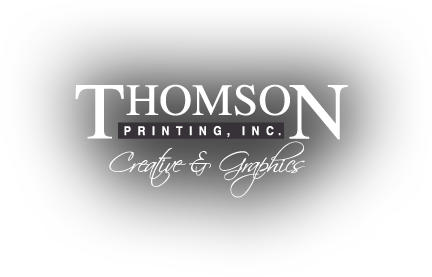From the original Banner News published in 1978
Mark Thomson did not make the usual turn into the Banner-News parking lot at 2431 Raymond Drive, St. Charles this morning. Instead, he pulled into a lot at 313 Droste Road to watch his son open the doors to Thomson Printing Co, Inc.
It is the first time in 73 years that the Banner-News has not counted a Thomson at the helm.
To tell the story of the 58 year old former owner is to tell the story of a man, a family, a newspaper and, to some extent, a town. His father, Ronald M. Thomson, came from Plymouth Ind., to purchase the Banner in 1905. Forty-One years later he turned its management over to his son, Mark Adam Thomson.
Mark Thomson was owner and publisher of the paper until August 1972 when he sold the newspaper-end of the business to Sun Communications in Fulton, but retainer ownership of the printing operations.
Carrying on the father-son tradition, Thomson is helping to open the small order printing division with his 24-year-old sone, Michael. His oldest son, Mark Jr, 26 is a contractor in San Francisco and his youngest Son, John, 20 is a student majoring in business at Central Methodist College, Fayette.
The senior Thomson took time out from his work in the “back of the shop” one day last week to reminisce about his years of association with the Banner.
He was born 15 years after his father had purchased the paper and, at the age of 12, began delivering newspapers in the small rural town. By the time he was in high school he was stoking the coal furnace in the morning, sweeping the shop at night and picking up skills of the trade in-between. He was soon doing “stereotype work” which in the days of hot type, involved pouring hot metal over mats to make plates for printing.
In 1941 he entered the Army Air Corps. He was a navigator bombadeer flyer B-52s over the South Pacific when tragedy struck the Thomson family and changed the direction of Mark’s life.
“I really had no intention of going back into the newspaper business,” he said “But my brother who had graduated from journalism school and was going to take over thew newspaper, was killed during the war.”
Ronald F. Thomson, died at the age of 26. He was Mark’s senior by two years. His mother, Elma Filar Thomson, died the same year.
“Then I came back and my father asked me if I wanted to take over. I said yes and went back up to journalism school,” he said. He took over management of the paper in 1946. His father retired in 1949 although, Thomson said, “He never did retire all the way. He was always down at the shop” located at the time at Main and Madison streets, next to the First State Capitol Building.
Ronald Thomson died in 1953, leaving Mark memories of a father who had endured monetary setbacks to uphold journalistic principles.
When he bought the paper in 1905, Ronald Thomson was an “outsider” and had trouble establishing credit in town, according to a Banner-News article published the day of his death. In the 1920s he became entangled in a fight for municipal ownership of the town’s electric plant.
Thomson took an editorial stand in favor of municipal ownership and found himself up against the monetary power of major utility but he refused to succumb to bribes, unlike other officials in town, Mark said. He also lost the battle.
“Those were lean years because certain advertisers would not advertise in the paper,” Mark said. “It made it pretty rough. We went from there right into the depressions.”
Mark’s sister, Juilia Gallais, and her husband, Lucien, helped with bookkeeping for the company for both her father and brother. They live in St. Louis.
Mark never graduated from journalism school but he did meet a young lady named Louise Weith who was majoring in advertising. She became his bride in 1947, ten days after she graduated. Both laugh today at the suggestion that she married Mark to find a job in her field.
“She started out selling advertising,” Mark said, “then she started writing women’s news.” She covered club meetings and award presentations and was expect to take pictures at each event. But she did not shine in her photographic endeavors. “I even bought her a Polaroid,” Mark claims. “She could mess that up, too.”
“I was truly bad,” Louis admits. Today, she says, when she sees reports taking pictures at a meeting, she “recalls what a horror it was.”
Mrs Thomson liked writing better than “pounding the payment,” she said, because “I wrote only about the happy things in St. Charles: weddings, engagements, honors . . . I could present people in their very best light.
However, she described her first years as the publishers wife as a “Bohemian life.” The young couple lived in an apartment above the Banner offices and printing plant.
“It was a dreadful place to live. People would want to pay for classified ads at all hours of the day and night. They would shake the door until the lock feb off then they came upstairs with there 64 cents or whatever it was.”
She recalled the first time the crew used a large eight-page paper roll on the printing press. ” Th building was terribly rickety, she explained. “The first time the first one (paper roll) was tipped on its side it knocked my dishes off the cabinet upstairs.
After that Mark would make sure I was in the office whenever they wanted to print an eight-page paper and I would run upstairs and hold the cabinet real secure.”
“I could not go back to it but it was fun,” she said.
Ask Mark about the hours he kept durning those years as a publisher and he will tell you, “When you own a small newspaper there is no such things as hours. When a subscriber misses the paper they call you and want you to deliver it. And you deliver it – or I did.”
“I guess it is like an other business. You have to make a profit to stay in business. There is a certain satisfaction to have a business and see it grow.”
One of the peaks in his tenure as publisher was buying out the Cosmos-Monitor, the competing paper in town, in 1959. A valley, or more aptly, the grand canyon, was watching his business burn to the ground Dec 1, 1972.
The Banner had moved to a building at Fifth and Adams streets Thomson owned the printing plant and Sun Communications owned the paper.
“I left about 5:10 that night and walked right past the furnace room where they said the fire started,” Mark said. At about 5:30 p.m, someone smelled smoked and called the fire department. “They came within five minutes and the place was gone. They called me about 10 minutes to 6:00. I stayed down there until about 9:00 then i came home.”
Although staff members and fire fighters were able to salvage some of the equipment, he had seen most of what he owned literally go up in smoke.
Leroy Halleneier, a pressman at the Banner who has worked with Mark since 1959, said Louis told him the night of the fire that the plant would open up again.
A Banners-News article published out of the former St. Charles Hotel the day after the fire reflected the same determination. “Mark Thomson’s printing company is also apparently a total loss but Thomson reportedly is preparing to set up business again as soon as possible,” it said.
Robert B.J.” Loeffler, a cameraman and platemaker, echoed Leroy’s sentiment. “I think if it hadn’t been for Louise, Mark would have just closed up.”
His presses were rolling again by Jan 20 in a new building at 601 N. Kingshighway. The newspaper staff continued to operate out of the hotel.
“That was really a jack-legged operation,” Thomson said. “The composing room and advertising were in the dinning room. Circulation, the photo lab and the wire machine were in the kitchen. The newsroom was in the restaurant.”
Ogden Newspapers purchased the entire operation, including Mark’s presses, soon after the fire and blueprints were drawn up for the presents building. Louise gave up writing for volunteer work with the St. Charles County Historical Society and Our Savior Lutheran Church and Mark continued, in his new roll.
As the Thomson watched the paper grow and change, they also became enveloped in a changing St. Charles.
“It used to be a nice small country town,” Mark said. “It has developed into a large suburban area now.”
Which was preferable? “Business-wise, a larger sunburn area; living-wise, a small town. I think many of the older residents probably would like it like it was.”
But, said the man who has adjusted to change in a family-owned business, “You can’t stand still.”.

